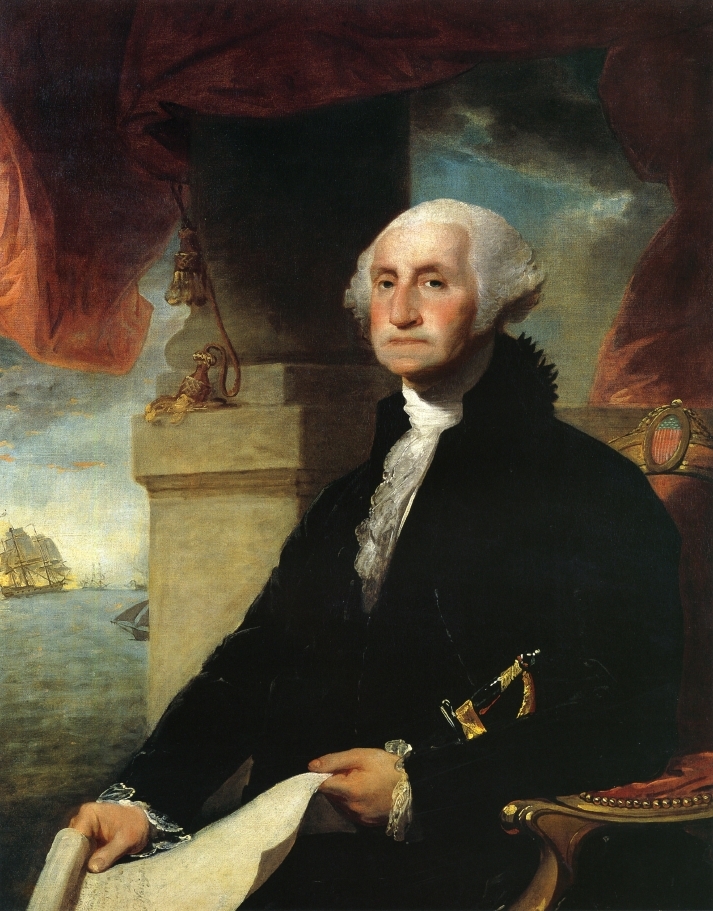“I feel my self going. I thank you for your attention. You had better not take any more trouble about me; but let me go off quietly; I cannot last long.”1 These were George Washington’s dying words. Who could have imagined that this great Revolutionary War hero and first President could fall two years after his retirement? He seemed to be immortal in the public’s eyes. Staying in the spotlight for nearly twenty five years, standing as the symbol of American nationhood, he not only had stood as a symbol of America, but he had also commanded the armies that helped gain national independence. After all the wars, he never appeared fazed, never showed any type of weakness or vulnerability, until that frigid winter of 1799.2
The century was nearly over, and the future of the young nation seemed bright. The former commander-in-chief of the nation had retired to his estate of Mount Vernon and had set out on horseback to check on certain areas of his plantation. It was December 12, 1799.3 He was exposed to cold rain and snow, but that did not stop this man from carrying out his responsibilities. However, sometimes carrying out responsibilities can have serious consequences. The next day he woke early in the morning, having difficulty breathing. Later in the morning he started to developed pain in the throat, and this led him to be unable to swallow or speak well. He grasped for some air, constantly tossing and turning to find a comfortable position.4 Lying down in agony, he was surrounded by three physicians who were all at a loss as to what to do.
James Craik, Gustavus Richard Brown, and Elisha Cullen Dick were the attending physicians for Washington, and all knew him very well.5 The first to arrive was Dr. Craik on Friday, December 13, when Washington started first experiencing a cold with a light hoarseness. By 2 a.m. the next morning, he awoke with troubled breathing. At 6 a.m. he was showing signs of a fever with throat pain and respiratory suffering.6 Washington was unable to swallow and even had difficulty speaking. Dr. Craik believed that the only option for Washington was for a bloodletting.
Bloodletting is the surgical removal of blood from a patient, and it was a typical procedure physicians used in the eighteenth century. Typically, the physicians were not the ones that would carry out the bloodletting; they would call in a skilled bloodletter. In this case, the bloodletter was George Rawlins. At 7:30 a.m., Rawlins removed about 12 to 14 ounces of Washington’s blood. Washington actually requested an additional bloodletting. Two hours later, Dr. Craik applied a blister of cantharides to Washington’s throat and removed roughly 18 more ounces of blood. This was also done at 11 a.m.7 Washington was still alert at this time. He even had the strength to stand up and walk to the bathroom, but he still had trouble swallowing tea, nearly suffocating from the attempt and unable to cough up the fluid.
There was an argument among the physicians caring for Washington, whether there should be a fourth bloodletting. Dr. Elisha Cullen Dick believed that more bloodletting would make Washington’s condition worse. Nevertheless, Dr. Craik ordered for the bloodletting at 3 p.m.8 After the fourth bloodletting, Washington seemed to show improvement; he was able to swallow. With renewed strength, Washington was able to revise his will. He knew his time was coming to an end. As the night continued, his condition steadily worsened. The physicians tried their best to keep him stable by applying blisters of cantharides to his arms, legs, and feet. They even applied wheat-bran cataplasms to his throat.9 This did stop his condition from worsening.

At 10 p.m., Washington whispered his burial instructions to his aide. Twenty minutes later, George Washington died. The news of his death spread rapidly across the country. The grieving was not only at his at burial site, but across the Atlantic. There was a London newspaper that eulogized: “His fame, bounded by no country, will be confined to no age.”10 Units of the British fleet that was blockading a harbor in France dropped their ensigns to half-mast. Napoleon ordered a ten-day requiem.11 In the United States, newspapers would publish poems from grieving women. People traveled to Mount Vernon to pay their respects. Citizens dressed in black clothing for months.12
December 26 was the official day of mourning. At dawn, there were sixteen cannons that were fired, and they continued to boom every half hour until 11 a.m. After the firing of the cannons, there was a march of troops to the Lutheran Church where Henry Lee gave a memorial of Washington that became immortal: “First in war, first in peace and first in the hearts of his countrymen, he was second to none in the humble endearing scenes of private life…The purity of his private character gave effulgence to his public virtues.”13 To pay tribute to the first president, Congress voted to construct a marble monument in the Capital building, which was still under construction in Washington, D.C. at the time. This was an appropriate tribute to a great man, and he will forever be immortal in our nation’s history.
- Salem Press Encyclopedia, January 2016, s.v. “George Washington’s Death.” ↵
- Salem Press Encyclopedia, January 2015, s.v. “George Washington,” by David Curtis Skaggs. ↵
- Salem Press Encyclopedia, January 2016, s.v. “George Washington’s Death.” ↵
- David M. Morens, “Death of a President,” New England Journal of Medicine, vol. 341, (December 1999): 1845. ↵
- David M. Morens, “Death of a President,” New England Journal of Medicine, vol. 341, (December 1999): 1845-1849. ↵
- David M. Morens, “Death of a President,” New England Journal of Medicine, vol. 341, (December 1999): 1845. ↵
- David M. Morens, “Death of a President,” New England Journal of Medicine, vol. 341, (December 1999): 1845. ↵
- David M. Morens, “Death of a President,” New England Journal of Medicine, vol. 341, (December 1999): 1845. ↵
- David M. Morens, “Death of a President,” New England Journal of Medicine, vol. 341, (December 1999): 1846. ↵
- Salem Press Encyclopedia, January 2016, s.v. “George Washington’s Death.” ↵
- Salem Press Encyclopedia, January 2016, s.v. “George Washington’s Death.” ↵
- David M. Morens, “Death of a President,” New England Journal of Medicine, vol. 341, (December 1999): 1846. ↵
- Salem Press Encyclopedia, January 2016, s.v. “George Washington’s Death.” ↵



73 comments
Eric Ortega Rodriguez
This is a very interesting article. I have read numerous passages on George Washington but I have never encountered one regarding his death. I found it bizarre how they would use bloodletting in order to keep Washington alive. I also find it interesting to read how so many people would pay tribute to George Washington. Overall, this was a very original topic selection and was very well written. Good work.
Averie Mendez
The medical procedures back then almost seemed a bit ridiculous. Nobody really knew how to care for Washington, or even what his diagnosis was then. The process of bloodletting itself seemed like a desperate last-resort attempt at keeping Washington alive just a little longer. It’s interesting to see how much we’ve improved medically. I can’t help but wonder what disease killed our first president.
Diego Terrazas
As the saying goes, “it is not about the beginning or the end, it is the rest of your story that defines you.” Washington accomplished many things in his prime. He essentially set the foundations of America. I can only imagine how much he was revered and how much more he was revered when he was near death. His legacy will never be forgotten.
Victoria Rodriguez
I really enjoyed reading this! When I first read the title I tried to think on whether or not I have heard how he died and I realized I did not. I think this is because he is such a rock in the U.S’s history and he is constantly referenced that it does not feel like he ever died. In a sense the memory and stories of him literally are forever written in history. I liked this article, it was a great article to read and learn from. I was surprised that Napoleon held a day of mourning.
Madison Downing
This was such a inspiring article to read by how you wrote about the love this nation gave to a great man like our first president George Washington. It broke the world’s heart after seeing him slip away from our grasp but because of what he had done for everyone on the planet he will be one of the greats that will never be forgotten.
Diego Aguilera
These are my favorite types of articles ! George Washington’s success are always discussed, so it is interesting to read of his final dying days. I really liked the use of your quote to begin your article as it really helped to captivate my attention, and keep me wanting to read more! your article was really well written. I would love to do more research more and more about Washington.
Lyzette Flores
As the first president of the United States, George Washington is somebody everybody knows. He was a man that accomplished many things for the better of our country. If only the resources that we have today would have been available back then, would he had lived a tad longer. Needless to say, his memory will always be remembered as we see his face every day.
Marina Castro
I enjoyed reading this article a lot. I love to read about history and popular characters. However, as a non American student, I am not very familiar with the history of the United States. Reading this article really educated me on the topic. George Washington has a role in history which many people are familiar with, but the story of his death surely is more unknown.
Damian Jennings
I am no historical person, but the information and research done to preserve image of Washington was well thought out and well put together. Seems like these people are immortal, for instance, every American should know that George Washington is on the 1$ bill, but I forget that people die and his death was unfortunate but greatly honored by the people in this time.
Donte Joseph
Personally, I had not known the accounts of George Washington’s death, so I am glad that this article had informed me of his death and what happened afterwards. The fact that a president was well respected and loved to the fact that people were arguing about how his death would be handled says a lot. Hearing that his death was important to many across the world is amazing.